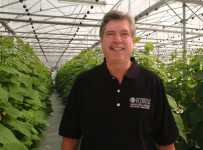The Future Of Protected Agriculture


Dan Cantliffe has seen greenhouse growing evolve during the course of his nearly four-decade long career as distinguished professor and chair of the horticultural sciences department at the University of Florida. With a new title and location as the county Extension director of Saint Johns County in Florida, we decided to catch up with him and get his input on the developments he has seen in the greenhouse industry and his predictions of what we should expect in protected ag in the future.
Q1 What are the three biggest advancements in greenhouse production you have seen in your career?
Cantliffe: The improvement of structures has changed drastically in the following ways: The cost has become much more affordable due to the movement away from the traditional, glasshouse structures. Materials such as plastic, aluminum, and steel bases have all improved greenhouse growing financially. Control systems have also taken a turn for the better in the way that a grower can now computerize the greenhouse so it can be operated remotely if needed. The increased use of hydroponics has allowed greenhouse growers to get away from soil, and the increased use of biological control allows growers to avoid using pesticides.
Q2 What are some of the benefits and difficulties of adopting a soilless culture?
Cantliffe: When you use a soilless culture, you don’t have to rely on soil fumigants. You can get away from problems with pathogens and weeds as well as nematodes. You can also develop a system where you can recycle fertilizer and water. I think some of the challenges, however, stem from difficulties with controlling the temperature in the greenhouse and managing irrigation. The facility management isn’t so bad, but the management of water usage takes some skill.
Q3 What government regulations have had the biggest impact on greenhouse vegetable growing and why?
Cantliffe: I think right now, labor is the biggest issue. That will continue to be a problem, especially with the proposed E-Verify program. Many of the larger greenhouse operations rely solely on local labor which is a major plus. Food safety and safety audits are also an issue. Anything related to pesticide use has also caused road bumps. Field growers are going to have more issues than greenhouse growers, though. Greenhouse growers don’t have as many problems with [fumigants such as] methyl bromide as they don’t have to use it.
Q4 With food safety issues mounting, where do you see greenhouse vegetable production in 10 years?
Cantliffe: I see it increasing dramatically. Although I don’t think it will be the major practice, I think it will dominate certain areas and crops such as tomatoes, peppers, and cucumbers. Of the crops mentioned, the majority of fresh produce in stores already comes from greenhouses. A large portion of tomatoes grown in the field will continue to go to food service outlets. There will always be a component of field production, but a lot of the production of high-quality crops can and will come from greenhouses.
Q5 What do you hope to accomplish in your new position with the University of Florida?
Cantliffe: I hope to keep agriculture strong. I am currently at the county level, trying to help growers maintain a stronger agriculture program. We’re seeing big changes in diversity and agritourism, so this is an exciting place to be.









